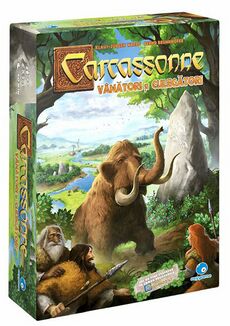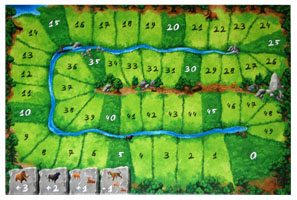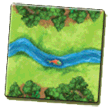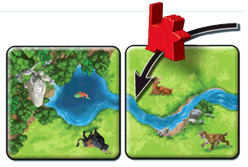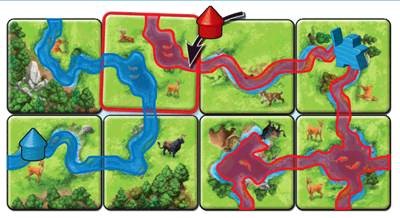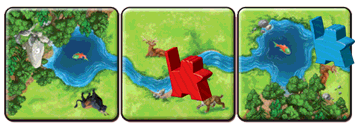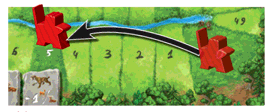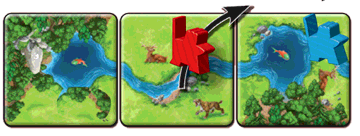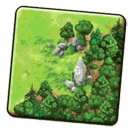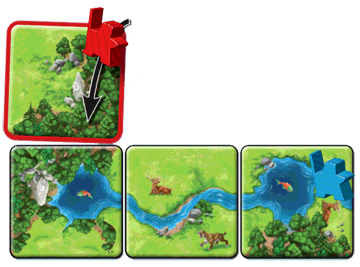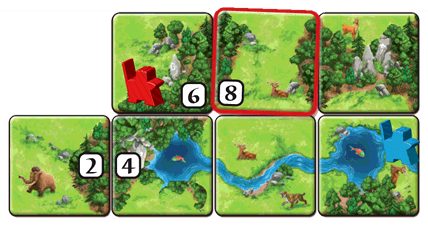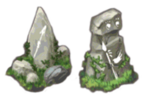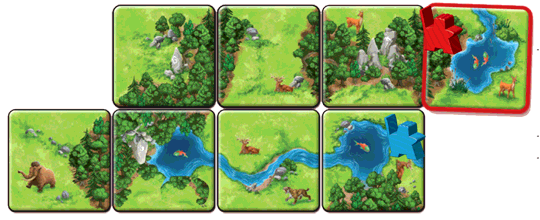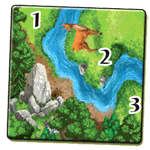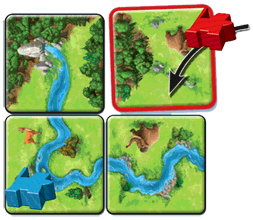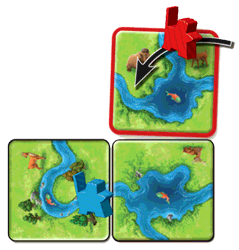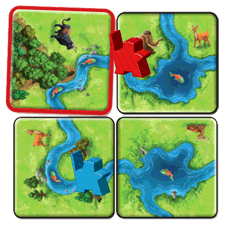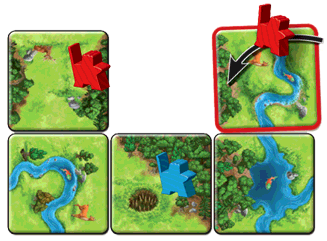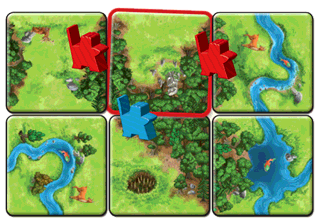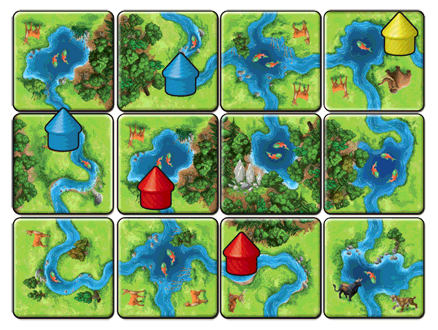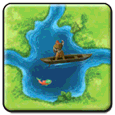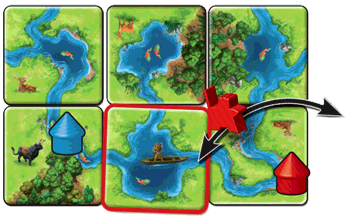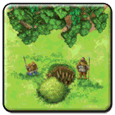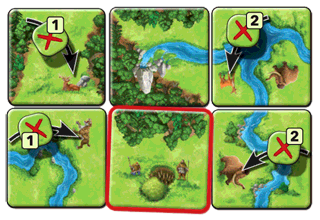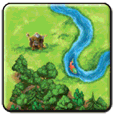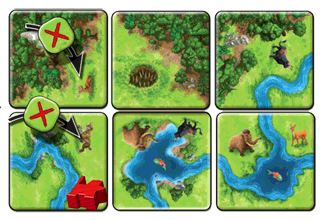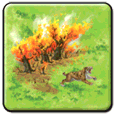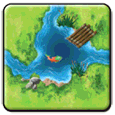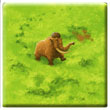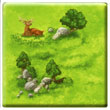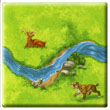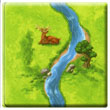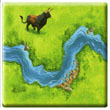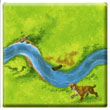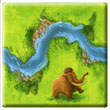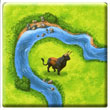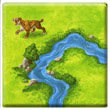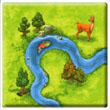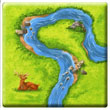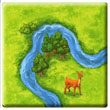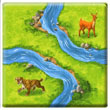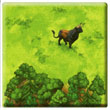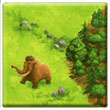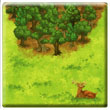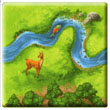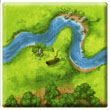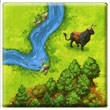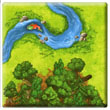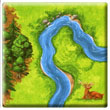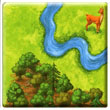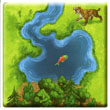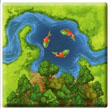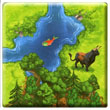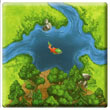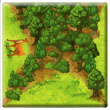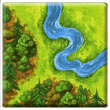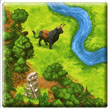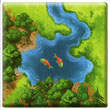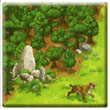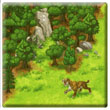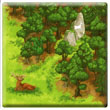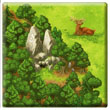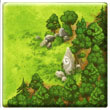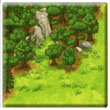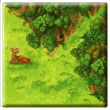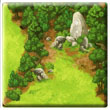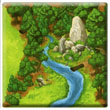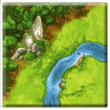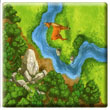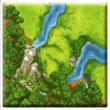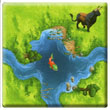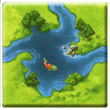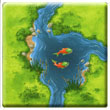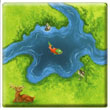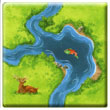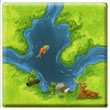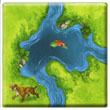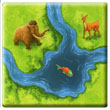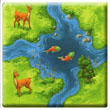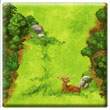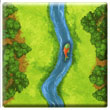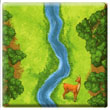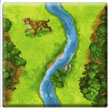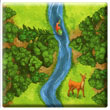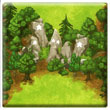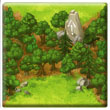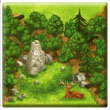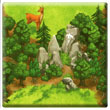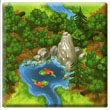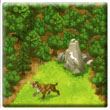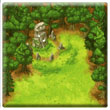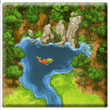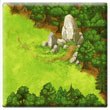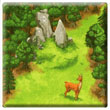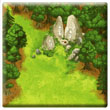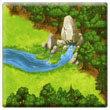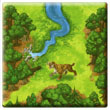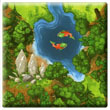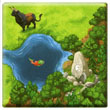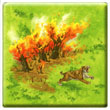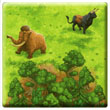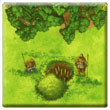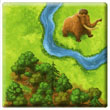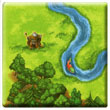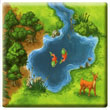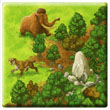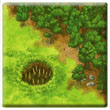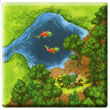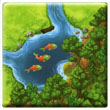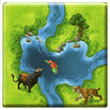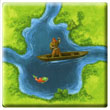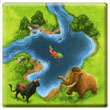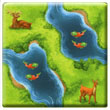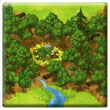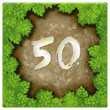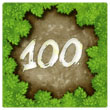Vânători și culegători: Jocul de bază
Cu mii de ani înainte ca oamenii din Carcassonne să fi construit ziduri și castele puternice, strămoșii lor populau ținutul. Aceștia vânau animale sălbatice, culegeau bace și prindeau pești pentru a își asigura supraviețuirea zilnică și prosperitatea continuată. Chiar și în ziua de azi, picturi rupestre fantastice și date preistorice stau mărturie pentru viața vibrantă care a existat în urmă cu multe generații.
Informații generale și comentarii
A doua ediție a jocului Vânători și culegători a fost lansată de Hans im Glück în 2020. Este un joc inteligent de plasare a cartonașelor pentru 2-5 jucători, cu vârste de 8 ani în sus. Jocul Vânători și culegători (a doua ediție) fost lansat de Lineart cu reguli traduse în limba română.
Ceea ce urmează este bazat pe versiunea ZMG a regulilor în engleză din 2020, cu orice erori evidente corectate, iar orice variații față de versiunea originală Hans im Glück incluse ca note de subsol.
Conținut
- 79 de cartonașe de teren (incluzând un cartonaș de pornire) cu păduri [incluzând unele păduri cu menhire (*)], râuri și lacuri cu pește, înconjurate de câmpie cu animale.
(*) Un menhir este un bloc masiv de piatră înălțat de oameni preistorici,
derivat din „men” ce înseamnă „piatră” și „hir” ce înseamnă „lung”.[1]
- 16 cartonașe „menhir” bonus
- 1 tablă de punctaj
- 5 cartonașe de puncte (50 pe față, 100 pe verso)
- 30 de membrii de trib în 5 culori
- 15 colibe în 5 culori
- 24 jetoane de acoperire
Prezentare generală
În fiecare tură, plasați cartonașe de teren pentru a crea un vast peisaj de păduri și câmpii. Aceste câmpii includ animale care pasc, precum și râuri și lacuri pline de pește. Trebuie să îți plasezi strategic membrii tăi de trib pe aceste cartonașe pentru a culege roadele pădurilor, câmpiilor, râurilor și lacurilor pentru tribul tău. Atunci când o faci, vei încasa puncte atât în timpul jocului, cât și la sfârșit. După evaluarea finală, jucătorul cu cele mai multe puncte câștigă jocul!
Pregătire
Plasează cartonașul de pornire (versoul cu un „C” întunecat) cu fața în sus în mijlocul mesei. Separă cartonașele de teren obișnuite de cartonașele menhir după verso. Amestecă cartonașele menhir și așază-le deoparte cu fața în jos într-un teanc. Amestecă cartonașele obișnuite și plasează-le cu fața în jos în mai multe teancuri astfel încât fiecare jucător poate ajunge cu ușurință la cel puțin 1 stivă.
Plasează tabla de punctaj lângă marginea mesei, mai încolo de cartonașul de pornire.
În cele din urmă, fiecare jucător obține membri de trib (numiți „meeple(și)” în reguli). Există 30 de meepleși, câte 6 în culorile galben, roșu, verde, albastru și mov. Există de asemenea 15 colibe, 3 în fiecare culoare.
Dă-i fiecărui jucător 5 meepleși și 3 colibe în culoarea la alegerea sa.
Plasează al șaselea meeple de fiecare culoare în uz pe câmpul 0 al tablei de punctaj. Înapoiază orice meepleși și colibe care nu se folosesc în cutie.
Desfășurarea jocului
Cel mai tânăr jucător efectuează prima tură, iar jocul continuă în sensul acelor de ceasornic până ce se termină cartonașele de teren.
Jucătorul actual efectuează următoarele acțiuni în ordine, înainte de a se continua cu tura următorului jucător:
Râuri și lacuri
1. Așezarea unui nou cartonaș de teren
2a. Plasarea unui meeple drept pescar pe un râu
Acest lucru este legal deoarece nu există alți meepleși pe acest râu.
Nu poate plasa un meeple pe râul de pe partea stângă a lacului, deoarece pe acel râu se află deja meepleul tău.
2b. Place a Hut on a River or Lake
Instead of placing a meeple, you may place a hut on either a river or a lake on the tile you just placed, but only if no other huts are present on the same river system.
A river system consists of all rivers connected to each other, including through lakes. While individual rivers end at lakes, rivers are connected to each other through lakes for the purpose of a river system. River systems end only at unconnected tile edges and forests.
Huts can be placed only on rivers or lakes. Huts remain where they are placed until the end of the game.
3. Scoring a river
A river is completed when both ends are closed by lakes or forests, or when it loops back onto itself by connecting to the other end. When a river is completed, it is scored. If one of your meeples is on a river when it scores, you will score points from it, regardless of who placed the tile that completed the river.
You score 1 point for each tile comprising the completed river, and 1 additional point for each fish present in the river and any lakes that close it. . After scoring, return the meeple(s) on the completed feature to their owner’s supply.
You have a meeple on the river, so you score 5 points: 3 points for the 3 tiles forming the river, and 2 for the 2 fish in the lakes.
Players track their scores using the meeples placed on the scoreboard at the start of the game. When you score points, advance your meeple that many spaces on the scoreboard. If your meeple passes the “0” space on the scoreboard, take a scoring marker and place it in front of you with the “50” side face-up. If your meeple passes the “0” space again, flip the marker to the “100” side.
These 3 steps are the general rules of the game. Other features have some important differences, explained below.
Forests
2. Place a Meeple as a Gatherer on a Forest
You may place a meeple on a forest tile you just placed as a gatherer. As with rivers, a meeple can be placed on a forest only if there are no other meeples present on that forest.
3. Score a completed forest
Normal Forest Scoring
A forest is completed when it is surrounded by grassland and has no internal gaps. If your gatherer is the only gatherer on the completed forest, you score 2 points for each tile comprising the completed forest. After scoring, return your meeple to your supply.
Because you completed a forest with a menhir, you begin an extra turn.
Menhirs
If you place a tile that completes a forest containing 1 or more menhirs, you take an extra turn[3], during which you place 1 of the set-aside menhir tiles. After scoring completed features during your current turn, begin an extra turn, drawing and placing a menhir tile from the menhir tile stack. As during a normal turn, you can place a meeple or a hut on the tile you just placed, and score any completed features. If you complete another forest containing 1 or more menhirs during an extra turn, you do not take an additional extra turn. You take only 1 extra turn, even if there are multiple menhirs in a completed forest. If there are no menhir tiles remaining in the menhir tile stack, you cannot take an extra turn.
You place the tile and place a gatherer on the forest.
The completed forest also contains a menhir, but you cannot begin an extra turn during an extra turn, so your turn ends as normal.
Menhir tiles are often more valuable than normal land tiles. Some menhir tiles have special actions associated with them; see Menhir Tiles.
Grasslands
2. Place a Meeple as a Hunter
You may place a meeple on a grassland tile you just placed as a hunter.
Unlike fishers and gatherers, hunters are placed on grasslands lying down, not standing up.
As with fishers and gatherers, you can place a hunter on a grassland only if there are no other hunters present on that grassland.
These are the core rules you need to know to begin playing. See below for detailed clarifications on specific rules.
Summary
1. Place a land tile
- You must draw and place a tile such that it connects to 1 or more tiles. The tile must continue each feature it is connected to.
- In the rare event that you are unable to place the tile you drew, return that tile to the box and draw a new tile to replace it.
2. Place a Meeple or a Hut
- A meeple or hut can be placed only on the tile you just placed.
- A meeple or hut can be placed only on a feature without another similar piece (meeple or hut).
3. Score completed features
- A river is completed when both ends are closed by lakes or forests, or when it loops back onto itself. A river scores 1 point for each tile, and 1 point for each fish in the river and any lakes that close it.
- A forest is completed when it is surrounded by grassland and has no internal gaps. A forest scores 2 points for each tile.
- Completed features are scored at the end of each turn in which 1 or more features are completed. Points are scored by the player whose meeple occupies a given feature.
- After scoring, all meeples on completed features are returned to their owners’ supplies.
- If you place a tile that completes a forest containing 1 or more menhirs, take an extra turn in which you draw and place a menhir tile. You cannot take multiple extra turns in a row.
- If multiple meeples are present on a single connected feature, the player with the most meeples on the feature scores points. In the event of a tie, all players tied for the most score the full points from the completed feature. For more information on how there can be multiple meeples on the same feature, see the following page.
Multiple meeples on the same feature
End of the Game, Final Scoring, and Determining the Winner
When the last land tile (not menhir tile) is placed, the game ends at the end of that turn. When the game ends, resolve the following steps:
- Leave all huts and hunters on tiles.
- Remove all other meeples from tiles. No points are scored for incomplete forests and rivers.
Final Scoring
Scoring Huts on River Systems
The player with the most huts on each river system scores 1 point for each fish shown in that river system. If multiple players are tied for the most huts, each tied player scores the full points for that river system. River systems do not need to be complete to be scored.
Scoring Hunters and Grasslands
Each hunter scores points based on the animals on its grassland.
The point value for each animal is shown on the scoreboard. A mammoth is worth 3 points, an aurochs 2 points, and a deer 1 point.
Saber-toothed tigers compete with hunters for prey. They hunt only deer, not mammoths or aurochs. For each saber-toothed tiger on a grassland, ignore 1 deer on that grassland.
To assist with scoring grasslands, use the covering markers to cover up pairs of tigers and deer. Then, score points for the remaining mammoths, aurochs, and deer. You do not lose points if there are more tigers than deer on a grassland.
If multiple players are tied for the most hunters on a grassland, each tied player scores the full points from that grassland. However, if one player has the most hunters, only they score from that grassland.
Grassland Scoring example
Grassland 1: 1 aurochs. Green scores 2 points
Grassland 2: 1 deer, 1 mammoth, 1 saber-toothed tiger. Red and Violet each score 3 points for the mammoth. The tiger and deer cancel each other out.
Grassland 3: 1 deer, 2 saber-toothed tigers. Blue does not score points, but does not lose points either.
Grassland 4: 2 mammoths, 2 aurochs, 2 deer, 1 saber-toothed tiger. Red has the most hunters, and scores 11 points (2 mammoths for 6 points, 2 aurochs for 4 points, and 1 deer for 1 point).
The player with the most points wins the game!
In the event of a tie, the tied players share the victory.
Menhir Tiles
Menhirs are found in forests, and when a forest with a menhir is completed, you take an extra turn in which you draw and place a menhir tile.
After placing a menhir tile, you can place a meeple or hut on it as normal.
Menhir tiles with more scoring opportunities
These tiles have more animals on their grasslands and more fish in their lakes and rivers. Otherwise, they function the same as normal land tiles.

Each group of mushrooms is worth 3 points when scoring a forest.
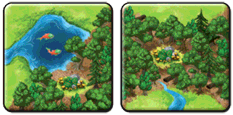
Menhir tiles with immediate actions
When you place a tile with an immediate action, you must immediately resolve the corresponding action.
You can place a meeple or hut on the tile, but are not required to do so to resolve the action.
You score points for the animals shown on the 8 surrounding tiles (orthogonally and diagonally adjacent to this tile) in the same grassland as the hunting trap.
It does not matter which tile this meeple is returned from.
Menhir tiles that affect final scoring
These tiles modify the value of the river system or grassland they are connected to.
Each animal (mammoth, aurochs, deer) on the 8 surrounding tiles (orthogonally and diagonally adjacent to this tile) in this grassland scores double points.
Credite
Designul jocului: Klaus-Jürgen Wrede, Bernd Brunnhofer
Artă: Marcel Gröber
Layout: Christof Tisch
Traducerea în engleză a regulilor: Adam Marostica
Ansamblul cartonașelor
Cartonașe obișnuite totale: 79
Cartonașe bonus totale: 16
Cartonașe de puncte totale: 5
Note de subsol
Pentru licențierea și semnificația pictogramelor te rugăm să vizitezi Pagina pictogramelor.
- ↑
 Regulile Hans im Glück, atunci când sunt traduse, spun pur și simplu că „Un menhir este un falnic bloc preistoric de piatră...”, dar nu menționează originea denumirii, care este din limba bretonă.
Regulile Hans im Glück, atunci când sunt traduse, spun pur și simplu că „Un menhir este un falnic bloc preistoric de piatră...”, dar nu menționează originea denumirii, care este din limba bretonă.
- ↑
 The ZMG version of the rules said "8" tiles - HiG version, and Dutch 999 Games version, correctly state "4".
The ZMG version of the rules said "8" tiles - HiG version, and Dutch 999 Games version, correctly state "4".
- ↑
 You don't have to have a follower in the forest to gain the extra turn, just be the one to close it.
You don't have to have a follower in the forest to gain the extra turn, just be the one to close it.
- ↑
 The Z-Man Games rules said "8 points" and "3" lakes - the Hans im Glück version correctly stated "4" lakes.
The Z-Man Games rules said "8 points" and "3" lakes - the Hans im Glück version correctly stated "4" lakes.
- ↑
 Or you could score 7 points by placing your fisher on the river occupied by Blue's Hut! There's an extra fish on the river, hidden by the hut. Both HiG and ZMG versions don't consider this.
Or you could score 7 points by placing your fisher on the river occupied by Blue's Hut! There's an extra fish on the river, hidden by the hut. Both HiG and ZMG versions don't consider this.
- ↑
 An early version of the ZMG rules stated that you "must" remove 1 of your meeples from play, rather than "may".
An early version of the ZMG rules stated that you "must" remove 1 of your meeples from play, rather than "may".
